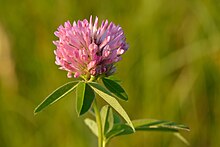
Clover or trefoil are common names for plants of the genus Trifolium, consisting of about 300 species of flowering plants in the legume or pea family Fabaceae. The genus has a cosmopolitan distribution with highest diversity in the temperate Northern Hemisphere, but many species also occur in South America and Africa, including at high altitudes on mountains in the tropics. They are small annual, biennial, or short-lived perennial herbaceous plants. Clover can be evergreen. The leaves are trifoliate, cinquefoil, or septfoil, with stipules adnate to the leaf-stalk, and heads or dense spikes of small red, purple, white, or yellow flowers; the small, few-seeded pods are enclosed in the calyx. Other closely related genera often called clovers include Melilotus and Medicago.

A shamrock is a young sprig, used as a symbol of Ireland. Saint Patrick, Ireland's patron saint, is said to have used it as a metaphor for the Christian Holy Trinity. The name shamrock comes from Irish seamróg[ˈʃamˠɾˠoːɡ], which is the diminutive of the Irish word seamair óg and simply means "young clover".
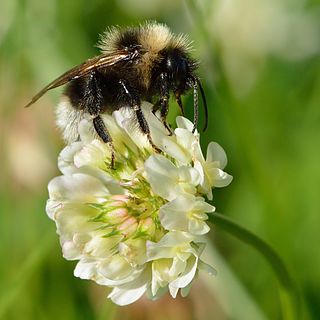
Trifolium repens, the white clover, is a herbaceous perennial plant in the bean family Fabaceae. It is native to Europe, including the British Isles, and central Asia and is one of the most widely cultivated types of clover. It has been widely introduced worldwide as a forage crop, and is now also common in most grassy areas of North America and New Zealand. The species includes varieties often classed as small, intermediate and large, according to height, which reflects petiole length. The term “white clover” is applied to the species in general, “Dutch clover” is often applied to intermediate varieties, and “ladino clover” is applied to large varieties.

Trifolium pratense, the red clover, is a herbaceous species of flowering plant in the bean family Fabaceae, native to Europe, Western Asia, and northwest Africa, but planted and naturalised in many other regions.

Trifolium aureum, known by the various common names large hop trefoil, large trefoil, large hop clover, golden clover or Hop clover, is a species of clover native to much of Eurasia.
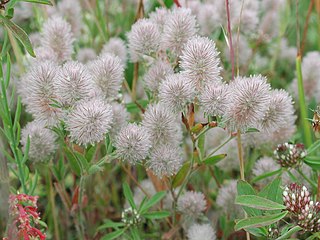
Trifolium arvense, commonly known as hare's-foot clover, rabbitfoot clover, stone clover or oldfield clover, is a flowering plant in the bean family Fabaceae. This species of clover is native to most of Europe, excluding the Arctic zone, and western Asia, in plain or mid-mountain habitats up to 1,600 metres (5,200 ft) altitude. It grows in dry sandy soils, both acidic and alkaline, soil with dry-mesic conditions and is typically found at the edge of fields, in wastelands, at the side of roads, on sand dunes, and opportunistically in vineyards and orchards when they are not irrigated.
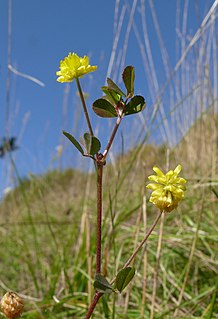
Trifolium campestre, commonly known as hop trefoil, field clover and low hop clover, is a species of clover native to Europe and western Asia, growing in dry, sandy grassland habitats, fields, woodland margins, roadsides, wastelands and cultivated land. The species name campestre means "of the fields".

Medicago lupulina, commonly known as black medick, nonesuch, or hop clover, is a plant of dry grassland belonging to the legume or clover family. Plants of the genus Medicago, or bur clovers, are closely related to the true clovers (Trifolium) and sweet clover (Melilotus). Like the true clovers, black medick has three leaflets and a small, yellow flower closely resembling those of lesser trefoil. Black medick belongs to the same genus as alfalfa.
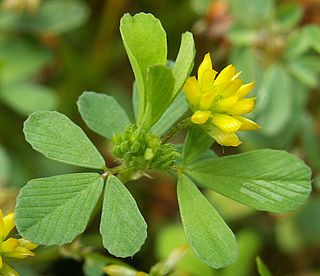
Trifolium dubium, the lesser trefoil, suckling clover, little hop clover or lesser hop trefoil, is a flowering plant in the pea and clover family Fabaceae. This species is generally accepted as the primary plant to represent the traditional Irish shamrock.
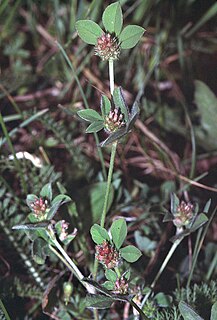
Trifolium striatum, the knotted clover, soft trefoil, is a plant species of the genus Trifolium.

Trifolium hybridum, the alsike clover, is a plant species of the genus Trifolium in the pea family Fabaceae. The stalked, pale pink or whitish flower head grows from the leaf axils, and the trifoliate leaves are unmarked. The plant is up to 40 centimetres (1.3 ft) tall, and is found in fields and on roadsides – it is also grown as fodder. The plant blooms from spring to autumn. Originating in mainland Europe, it has become established as an introduced plant in the British Isles and throughout the temperate regions of the world.
Trifolium resupinatum is an annual clover used as fodder and hay, which reaches 60 cm (24 in) tall when cultivated, and forms rosettes when grazed or mowed. It is native to central and southern Europe, the Mediterranean, and southwest Asia as far south as the Punjab. It is an important hay crop in cold regions of Iran, Afghanistan and other Asian areas with cold winters.

Trifolium angustifolium is a species of clover known by the common names narrowleaf crimson clover, narrow clover and narrow-leaved clover.

Trifolium depauperatum is a species of clover known by the common names cowbag clover, poverty clover, and balloon sack clover.

Trifolium glomeratum is a species of clover known by the common names clustered clover and bush clover. It is native to Eurasia and North Africa and it is known elsewhere as an introduced species. It easily takes hold in disturbed areas, becoming a common weed. It is an annual herb growing decumbent to upright in form with mostly hairless herbage. The leaves are made up of oval leaflets up to 1.2 centimeters in length. The inflorescences occur in leaf axils, each a headlike cluster of many flowers. Each flower has a calyx of sepals with triangular points that bend outward, and a pink corolla.
Trifolium gracilentum is a species of clover known by the common names pinpoint clover and slender clover. It is native to western North America including the west coast of the United States and northwestern Mexico, where it grows in many types of habitat, including disturbed areas. It is an annual herb growing prostrate to erect in form with mostly hairless or slightly hairy herbage. The leaves are made up of lance-shaped to oval leaflets. The inflorescence is an umbel of flowers that spread out or flex downward. The flowers have pink or purple corollas less than a centimeter long.

Trifolium microcephalum is a species of clover known by the common names smallhead clover and small-headed clover.

Trifolium variegatum is a species of clover known by the common name whitetip clover. It is native to western North America from southern Alaska and British Columbia to Baja California, where it occurs in many types of habitat.

Trifolium occidentale, the western clover, is a clover plant belonging to the genus Trifolium in the legume family, Fabaceae. Its flowers are white, similar to white clover, with which it has long been confused. This species lives almost exclusively in sand dunes and sea cliffs on the Atlantic coast of Europe, especially Cornwall and the Channel Islands. The species was first described in 1961 by Dr David E Coombe of Cambridge University.
Trifolium micranthum, the slender trefoil or slender hop clover, is a plant species of the genus Trifolium in the "pea family" ; Fabaceae or Papillionaceae.
